Summer has bid us farewell. School is back in session. I have no vivid recollection of activities that occurred between the start of summer and the beginning of the school session. I know I worked maybe just a little too much and I’m getting used to my new commute to Midtown. It’s always been a dream of mine to hike the Great Wall of China. Two weeks commuting in the NYC subways, squeezing into sardine packed cars, waiting for delayed trains, climbing stairs and more stairs, I no longer desire to visit or view first hand that aforementioned Wall, stairs included.
Fulton Street subway station is a wonder of the world in itself, no need to visit a very far land in search of physically challenging stairs to conquer. More challenging is sprinting up the many stairs to catch a train when one is late for work. It’s not uncommon to see older folks huddled over the handrails trying to catch their breath. I shall not confess whether I’m included in that statistic. I am in dire need of a vacation. Diwali is later this month and I may hop on a plane to experience again the wonders of the festival of lights, after two decades in exile. I will violate every law of moderation and indulge in excess parsad consumption to soothe my troubled, weary soul. Amen.
Parsad or mohanboug, for those of you who are not familiar with the words, is a traditional sweet served at Hindu religious ceremonies in Trinidad and other countries in the Caribbean.
There are several versions of parsad, one is made solely with flour, and another is made with just cream of wheat. Then there is this recipe that combines both (I have now also included the recipe for the flour version below).
The color will also vary by personal preference and region, for example, my cousin likes hers light in color and our Guyanese neighbors make it much darker. I make it somewhere in the middle, just like my great-grandmother. At least that’s what my mom says. The color of the parsad varies according to the length of time the flour is cooked (or your preference), aka parched, and the moistness and fluffiness will vary depending on the fat used.
In this version, flour and/or cream of wheat are cooked in ghee until golden brown, then raisins, ginger, and ground cardamom (elaichi) are added. It’s all brought together with a syrup (phaag) made with milk, sugar, and water, which results in a fluffy, pillowy, soft, indulgent dessert.
Because of the length of these devotions, the young rebel in me opted to hang out and chat with the cooks who were busy preparing huge iron pots of vegetarian dishes and paratha roti, which were to be served at the end of the pooja to the prayer devotees and non (those who came only for the food and sweets). This meant that I had to perform dishwashing, bell girl, and sous chef duties, but those responsibilities were so much more bearable and exciting than sitting still and waiting for the prayers to end.
I believe that this is one of the reasons I could now easily prepare a feast for a hundred people. I gained priceless experience and knowledge by observing the older generation of cooks. Nowadays, I am much better behaved, obedient, and spiritual, and on an occasional Sunday, you will find me sitting for several hours in church, even though there are no sweet treats or food served at the end of service. I bring my own.
Some folks enjoy their parsad warm and soft, others like it cold and hard straight out of the refrigerator. I don’t discriminate. I eat it any way I get it, except if it’s too white, which means that the flour was not parched sufficiently in the ghee, which results in a bland, raw flour taste.
Around Diwali time, when all my family and friends in Trinidad are enjoying an abundance of parsad (and prayer’s food), because of the frequency of pooja’s everywhere, I usually prepare a small batch to satisfy my craving, console myself and reminisce about my childhood. That is all I seem to do these days: cook, eat, and reminisce. Repeat. Hopefully, this year will be different.
Read my post on Diwali: Diwali and what it means to me–Here you will also find all the Diwali Recipes on this blog.
Cook’s “managing my weight” Tip—If you plan to make parsad as often as I do for your own personal satisfaction, you may decrease the ghee and sugar to half cup each. Just a suggestion. Calm down.
Use this recipe if you want consistent results every time! No more calling Aunties, Tanties or Grandmas to ask them how to make parsad… I did all the work for you…Seven years (updated 2018) of investigating, interrogating, and testing to bring you the authentic taste of parsad. I hope you enjoy it.
How to Make Parsad
Cream of Wheat Parsad
Serves 8-10
2 cups water
3/4 cup ghee (clarified butter) ( I prefer Cow Brand Ghee)
1 cup all purpose flour
1 cup instant cream of wheat (farina)
½ cup golden raisins (Optional)
2 tablespoons grated fresh ginger, or more for a more gingery flavor
1 teaspoon ground elaichi (cardamom), or more to taste
Flour Parsad
Serves 8-10
2 cups water
2 cups all purpose flour (approx. .532 lb or 8.5 oz)
1 cup golden raisins (Optional) (5 oz)
2 tablespoons grated fresh ginger, or more to your liking
1 – 2 teaspoons ground elaichi (cardamom)
For a sweeter parsad, add 1.5 cups sugar.
Make Syrup:
In a small saucepan with a long handle, add evaporated milk, whole milk, one cup of water and sugar and place over a low flame. Stir until sugar has melted. Keep on low flame.
To cook:
Meanwhile, in a large heavy bottomed pot over medium low heat(my wide all clad pan worked wonders and cooked the flour in record time), add ghee.
When it melts, gradually sprinkle in flour (or sift flour into pot) and stir, using a wooden spoon in a rapid back and forth motion, scraping the flour from the bottom of the pot so it doesn’t burn. You sprinkle in flour to prevent lumps in the parsad.
[If the flour is becoming brown too quickly, lower the heat.]
Cook (parch), stirring continuously, scraping the bottom of the pot, until the flour is golden brown, like the color of tea with milk(or a little lighter if that’s your preference), and light in weight, about 5-7 minutes(may take longer on your stove).
Add raisins, grated ginger and elaichi and cook 3 more minutes…
…until raisins are plump…
Start pouring the hot milk mixture gradually (one cup or ladle at a time) into the pot, (and carefully since the syrup will splatter).
Turn vigorously and rapidly in a back and forth motion, until the cream of wheat is cooked and all the liquid is absorbed, about 5-7 minutes–depending on your pot or the heat. It may look “pasty” for a little while, don’t lose courage or confidence, success is just around the corner–just keep those arms moving.
The parsad is finished when it starts to clump together, your arms are dead tired and sweat is pouring from your forehead. No exaggeration…..and most importantly, the parsad is fluffy, pillowy soft, light…the aroma heavenly…
With love,
Ria
Parsad - Two Versions
Ingredients
Flour Parsad Serves 8-10
- 1 can evaporated milk 12 oz, “Carnation”
- 1 cup whole milk
- 2 cups water
- 1 cup granulated sugar (8 oz)
- 1 cup ghee clarified butter ( I prefer Cow Brand Ghee), (8 oz )
- 2 cups all-purpose flour approx. .532 lb or 8.5 oz
- 1 cup raisins golden, Optional (5 oz)
- 2 tablespoons grated fresh ginger grated fresh, or more to your liking
- 1 - 2 teaspoons cardamom elaichi, ground
Cream of Wheat Parsad Serves 8-10
- 1 can evaporated milk 12 oz
- 1 cup whole milk
- 2 cups water
- 1 cup granulated sugar or more for a sweeter result
- 3/4 cup ghee clarified butter ( I prefer Cow Brand Ghee)
- 1 cup all purpose flour
- 1 cup instant cream of wheat farina, instant
- ½ cup golden raisins Optional
- 2 tablespoons grated fresh ginger or more for a more gingery flavor
- 1 teaspoon cardamom elaichi, ground, or more to taste
- For a sweeter parsad add 1.5 cups sugar.
Instructions
- Peel, grate ginger and measure ingredients.
- Make Syrup: In a small saucepan with a long handle, add evaporated milk, whole milk, one cup of water and sugar and place over a low flame. Stir until sugar has melted. Keep on low flame. [A few times I added the ginger to the milk and it curdled, so I no longer bother. You may continue to use the milk if it curdled, I didn't notice a difference to the final product]
To cook:
- Meanwhile, in a large heavy bottomed pot over medium low heat(my wide all clad dutch oven worked wonders and cooked the flour in record time), add ghee.
- When it melts, gradually sprinkle in flour (or sift flour into pot) and stir, using a wooden spoon in a rapid back and forth motion, scraping the flour from the bottom of the pot so it doesn't burn. You sprinkle in flour to prevent lumps in the parsad. [If the flour is becoming brown too quickly, lower the heat.] Cook (parch), stirring continuously, scraping the bottom of the pot, until the flour is golden brown, like the color of tea with milk(or a little lighter if that's your preference), and light in weight, about 5-7 minutes(may take longer on your stove). If you prefer a lighter color, cook on the lowest heat for a longer period 17-25 minutes.
- If you are making the cream of wheat version, add cream of wheat and continue to stir continuously, about 3 minutes. If not, skip this step.
- Add raisins, grated ginger and elaichi and cook 3 more minutes until raisins are plump.
- Start pouring the hot milk mixture gradually (one cup or ladle at a time) into the pot, (and carefully since the syrup will splatter). Feel free to ask your significant other or other trustworthy person to assist you in pouring the hot milk mixture into the pot. I pour one cup at a time--but quickly--because I find that it's easier to turn that way. Turn vigorously and rapidly in a back and forth motion, until the cream of wheat is cooked and all the liquid is absorbed, about 5-7 minutes--depending on your pot or the heat. It may look "pasty" for a little while, don't lose courage or confidence, success is just around the corner--just keep those arms moving.
- The parsad is finished when it starts to clump together, your arms are dead tired and sweat is pouring from your forehead. No exaggeration and most importantly, the parsad is fluffy, pillowy soft, light and the aroma heavenly. [It may seem a little greasy, but as it cools the grease will be absorbed to keep it at the right "parsad" texture.]
Video
SAMPLE TRADITIONAL “VEGETARIAN” DIWALI MENU
(Using recipes already posted)
TRVDiscDefault::1201
DIWALI


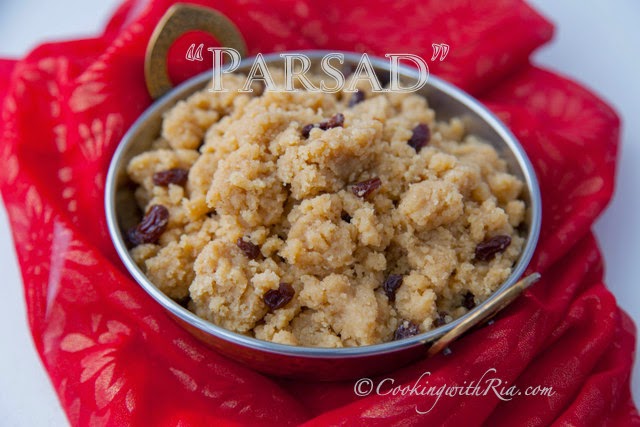
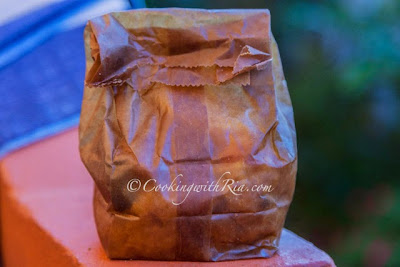

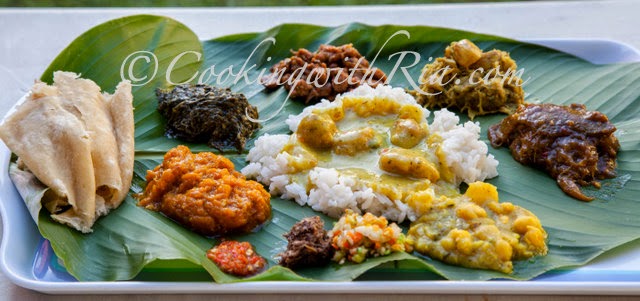

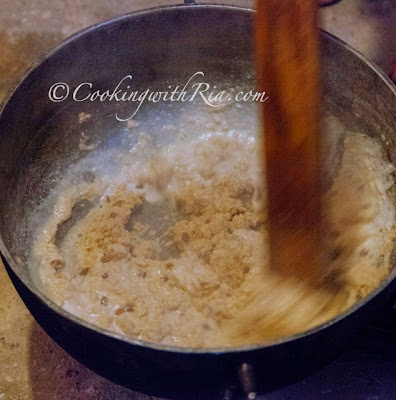

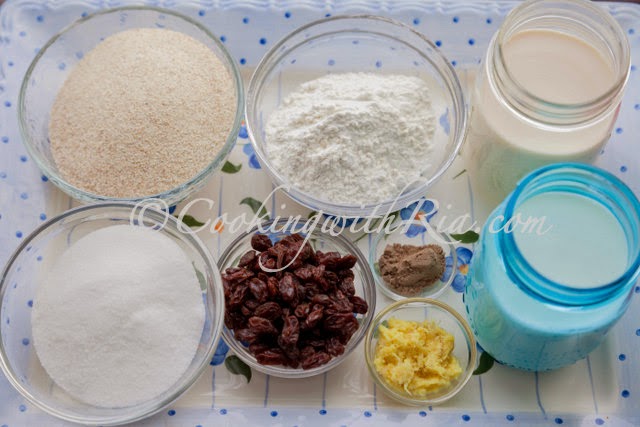




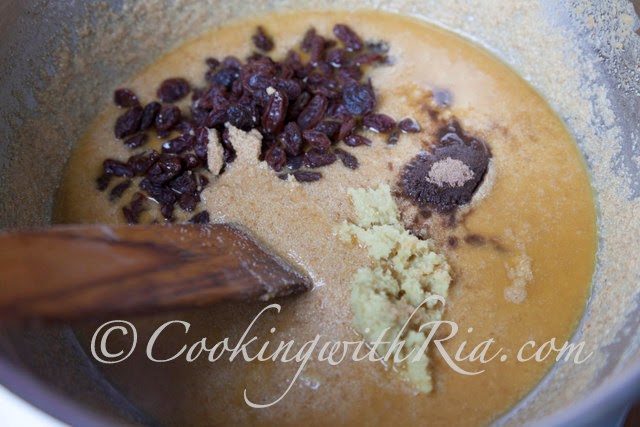


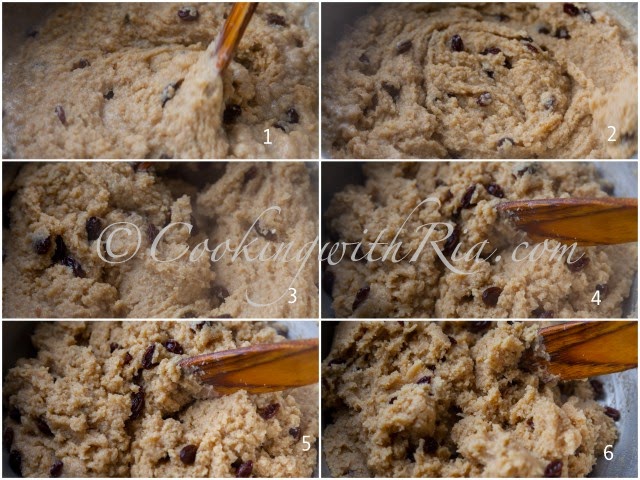


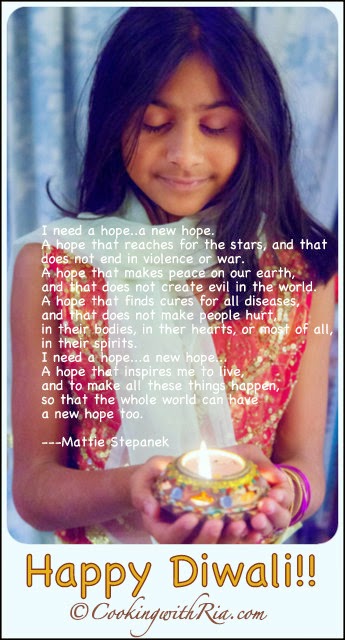












Thanks for taking the time … to sharing your recipes and love of Trini food.